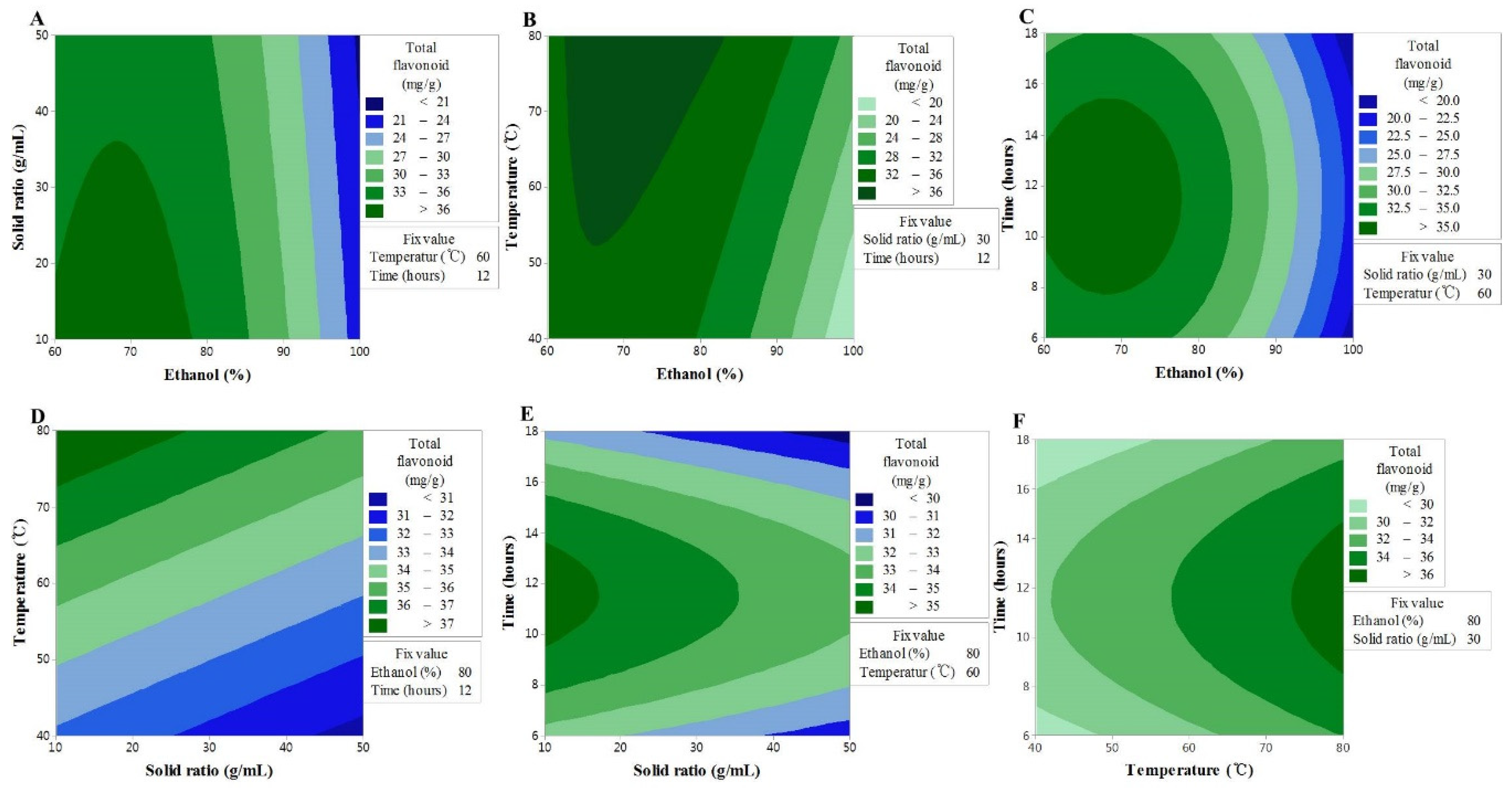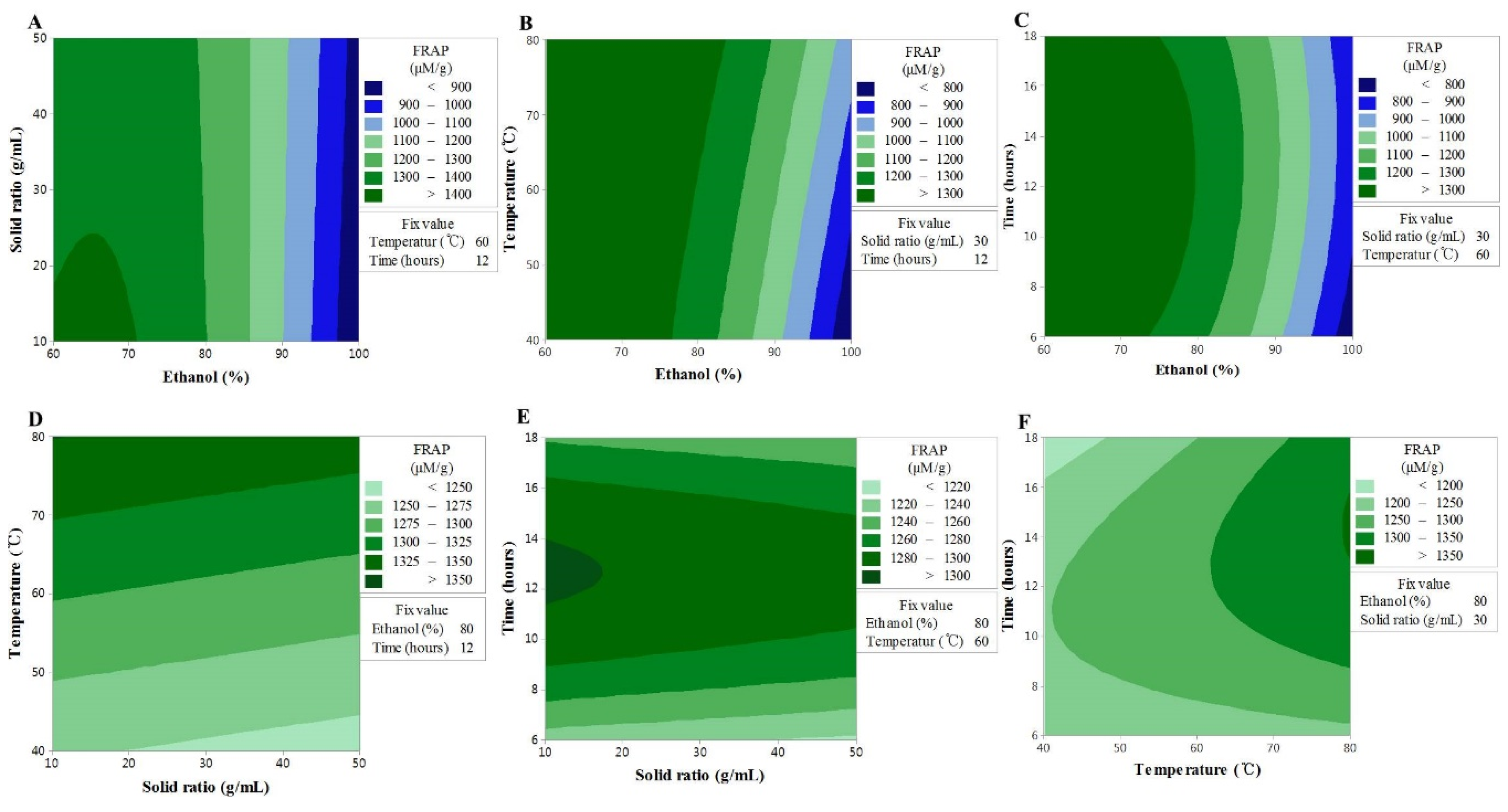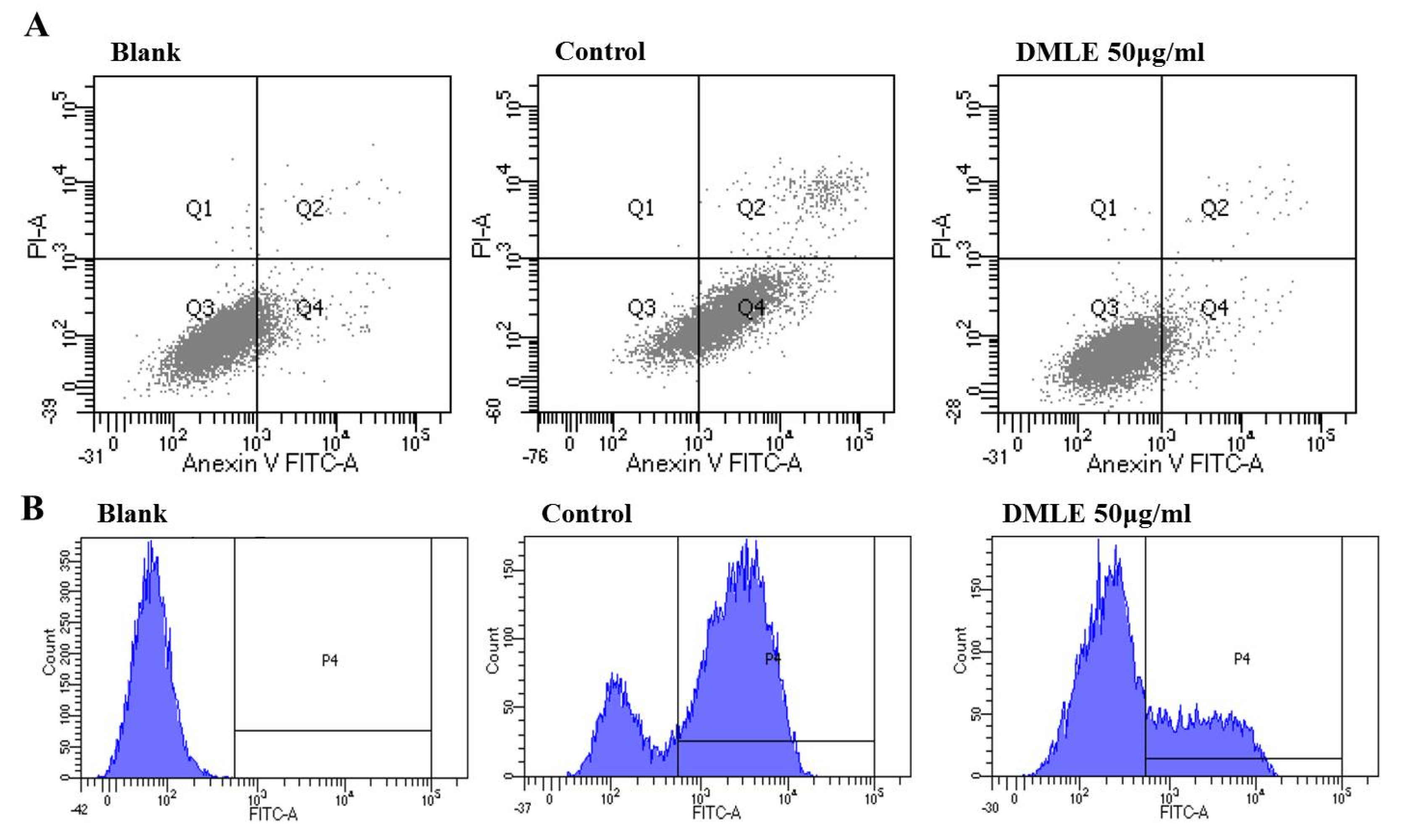Dendropanax morbifera Leaf Polyphenolic Compounds: Optimal Extraction Using the Response Surface Method and Their Protective Effects against Alcohol-Induced Liver Damage
Abstract
1. Introduction
2. Materials and Methods
2.1. Chemicals and Reagents
2.2. Plant Materials and Extraction
2.3. RSM Experimental Design
2.4. Total Flavonoids (TF) Content
2.5. Trolox Equivalent Antioxidant Capacity (TEAC)
2.6. Ferric Reducing Antioxidant Power (FRAP)
2.7. Cell Culture and Cytotoxicity Determination Using an MTT Assay
2.8. Apoptosis Analysis using Flow Cytometry
2.9. Cellular ROS Measurement using Flow Cytometry
2.10. HPLC Q-TOF Mass Analysis
2.11. Chlorogenic Acid and Rutin Quantification in DMLE
2.12. Statistical Analysis
3. Results and Discussion
3.1. Optimized Extraction of D, morbifera Leaf Extracts
3.2. Effect of Extraction Variables on TF
3.3. Effect of Extraction Variables on FRAP
3.4. Effect of Extraction Variables on TEAC
3.5. Determination and Validation of the Optimal Conditions
3.6. Toxicity of EtOH and Hepatoprotective Effects of DMLE
3.7. DMLE Inhibited EtOH Induced Apoptosis and ROS Production
3.8. Chemical Composition Analysis in DMLE
4. Conclusions
Author Contributions
Funding
Conflicts of Interest
References
- Lieber, C.S. Ethanol metabolism, cirrhosis and alcoholism. Clin. Chim. Acta 1997, 257, 59–84. [Google Scholar] [CrossRef]
- Doody, E.E.; Groebner, J.L.; Walker, J.R.; Frizol, B.M.; Tuma, D.J.; Fernandez, D.J.; Tuma, P.L. Ethanol metabolism by alcohol dehydrogenase or cytochrome P450 2E1 differentially impairs hepatic protein trafficking and growth hormone signaling. Am. J. Physiol. Liver Physiol. 2017, 313, G558–G569. [Google Scholar] [CrossRef] [PubMed]
- Li, B.; Lei, S.-S.; Su, J.; Cai, X.-M.; Xu, H.; He, X.; Chen, Y.-H.; Lu, H.-X.; Li, H.; Qian, L.-Q.; et al. Alcohol Induces More Severe Fatty Liver Disease by Influencing Cholesterol Metabolism. Evidence-Based Complement. Altern. Med. 2019, 2019, 7095684. [Google Scholar] [CrossRef] [PubMed]
- Zima, T.; Fialova, L.; Mestek, O.; Janebova, M.; Crkovska, J.; Malbohan, I.; Stipek, S.; Mikulikova, L.; Popov, P. Oxidative stress, metabolism of ethanol and alcohol-related diseases. J. Biomed. Sci. 2001, 8, 59–70. [Google Scholar] [CrossRef]
- Herath, K.H.I.N.M.; Cho, J.; Kim, A.; Kil Eom, T.; Kim, J.-S.; Kim, J.-B.; Doh, Y.H.; Jee, Y. Phenolic acid and flavonoid-rich fraction of Sasa quelpaertensis Nakai leaves prevent alcohol induced fatty liver through AMPK activation. J. Ethnopharmacol. 2018, 224, 335–348. [Google Scholar] [CrossRef]
- Herath, K.H.I.N.M.; Bing, S.J.; Cho, J.; Kim, A.; Kim, G.; Kim, J.-S.; Kim, J.-B.; Doh, Y.H.; Jee, Y. Sasa quelpaertensis leaves ameliorate alcohol-induced liver injury by attenuating oxidative stress in HepG2 cells and mice. Acta Histochem. 2018, 120, 477–489. [Google Scholar] [CrossRef]
- Kim, M.; Park, Y.J.; Lim, H.-S.; Lee, H.-H.; Kim, T.-H.; Lee, B. The Clinical Effects of Dendropanax Morbifera on Postmenopausal Symptoms: Review Article. J. Menopausal Med. 2017, 23, 146–155. [Google Scholar] [CrossRef]
- Hyun, T.K.; Kim, M.-O.; Lee, H.; Kim, Y.; Kim, E.; Kim, J.-S. Evaluation of anti-oxidant and anti-cancer properties of Dendropanax morbifera Léveille. Food Chem. 2013, 141, 1947–1955. [Google Scholar] [CrossRef]
- Hyun, T.K.; Ko, Y.-J.; Kim, E.-H.; Chung, I.-M.; Kim, J.-S. Anti-inflammatory activity and phenolic composition of Dendropanax morbifera leaf extracts. Ind. Crop. Prod. 2015, 74, 263–270. [Google Scholar] [CrossRef]
- Birhanu, B.T.; Kim, J.-Y.; Hossain, A.; Choi, J.-W.; Lee, S.-P.; Park, S.-C. An in vivo immunomodulatory and anti-inflammatory study of fermented Dendropanax morbifera Léveille leaf extract. BMC Complement. Altern. Med. 2018, 18, 222. [Google Scholar] [CrossRef]
- Kang, M.-J.; Kwon, E.-B.; Ryu, H.W.; Lee, S.; Lee, J.-W.; Kim, D.-Y.; Lee, M.K.; Oh, S.-R.; Lee, H.-S.; Lee, S.U.; et al. Polyacetylene from Dendropanax morbifera Alleviates Diet-Induced Obesity and Hepatic Steatosis by Activating AMPK Signaling Pathway. Front. Pharmacol. 2018, 9, 537. [Google Scholar] [CrossRef] [PubMed]
- Cheok, C.Y.; Salman, H.A.K.; Sulaiman, R. Extraction and quantification of saponins: A review. Food Res. Int. 2014, 59, 16–40. [Google Scholar] [CrossRef]
- Sharif, K.M.; Rahman, M.M.; Azmir, J.; Mohamed, A.; Jahurul, M.H.A.; Sahena, F.; Zaidul, I.S.M. Experimental design of supercritical fluid extraction—A review. J. Food Eng. 2014, 124, 105–116. [Google Scholar] [CrossRef]
- Yolmeh, M.; Jafari, S.M. Applications of Response Surface Methodology in the Food Industry Processes. Food Bioprocess Technol. 2017, 10, 413–433. [Google Scholar] [CrossRef]
- Said, K.A.M.; Amin, M.A.M. Overview on the Response Surface Methodology (RSM) in the Extraction Process. J. Appl. Sci. Process Eng. 2015, 2, 8–17. [Google Scholar]
- Khanam, U.K.S.; Oba, S.; Yanase, E.; Murakami, Y. Phenolic acids, flavonoids and total antioxidant capacity of selected leafy vegetables. J. Funct. Foods. 2012, 4, 979–987. [Google Scholar] [CrossRef]
- Zulueta, A.; Esteve, M.J.; Frigola, A. AORAC and TEAC assays comparison to measure the antioxidant capacity of food products. Food Chem. 2009, 114, 310–316. [Google Scholar] [CrossRef]
- Benzie, I.F.F.; Strain, J.J. The ferric reducing ability of plasma (FRAP) as a measure of “antioxidant power”: the FRAP assay. Anal. Biochem. 1996, 239, 70–76. [Google Scholar] [CrossRef]
- Chew, K.K.; Koo, M.Z.; Ng, S.Y.; Too, Y.Y.; Aida, W.M.W.; Ho, C.X. Effect of ethanol concentration, extraction time and extraction temperature on the recovery of phenolic compounds and antioxidant capacity of Orthosiphon stamineus extracts. Int. Food Res. J. 2011, 18, 1427–1435. [Google Scholar]
- Dahmoune, F.; Nayak, B.; Moussi, K.; Remini, H.; Madani, K. Optimization of microwave-assisted extraction of polyphenols from Myrtus communis L. leaves. Food Chem. 2015, 166, 585–595. [Google Scholar] [CrossRef]
- Azahar, N.F.; Gani, S.S.A.; Mokhtar, N.F.M. Optimization of phenolics and flavonoids extraction conditions of Curcuma Zedoaria leaves using response surface methodology. Chem. Central J. 2017, 11, 96. [Google Scholar] [CrossRef] [PubMed]
- Tan, M.C.; Tan, C.P.; Ho, C.W. Effects of extraction solvent system, time and temperature on total phenolic content of henna (Lawsonia inermis) stems. Int. Food Res. J. 2013, 20, 3117–3123. [Google Scholar]
- Naczk, M.; Shahidi, F. Extraction and analysis of phenolics in food. J. Chromatogr. A 2004, 1054, 95–111. [Google Scholar] [CrossRef]
- Muniyandi, K.; George, E.; Sathyanarayanan, S.; George, B.P.; Abrahamse, H.; Thamburaj, S.; Thangaraj, P.; Thanagraj, P. Phenolics, tannins, flavonoids and anthocyanins contents influenced antioxidant and anticancer activities of Rubus fruits from Western Ghats, India. Food Sci. Hum. Wellness 2019, 8, 73–81. [Google Scholar] [CrossRef]
- Alberti, A.; Zielinski, A.A.F.; Zardo, D.M.; Demiate, I.M.; Nogueira, A.; Mafra, L.I. Optimisation of the extraction of phenolic compounds from apples using response surface methodology. Food Chem. 2014, 149, 151–158. [Google Scholar] [CrossRef]
- Firuzi, O.; Lacanna, A.; Petrucci, R.; Marrosu, G.; Saso, L. Evaluation of the antioxidant activity of flavonoids by “ferric reducing antioxidant power” assay and cyclic voltammetry. Biochim. et Biophys. Acta (BBA)-Gen. Subj. 2005, 1721, 174–184. [Google Scholar] [CrossRef]
- Zhou, Y.; Zheng, J.; Gan, R.-Y.; Zhou, T.; Xu, N.-P.; Li, H.-B. Optimization of Ultrasound-Assisted Extraction of Antioxidants from the Mung Bean Coat. Molecules 2017, 22, 638. [Google Scholar] [CrossRef]
- Choi, H.-J.; Park, D.-H.; Song, S.-H.; Yoon, I.-S.; Cho, S.-S. Development and Validation of a HPLC-UV Method for Extraction Optimization and Biological Evaluation of Hot-Water and Ethanolic Extracts of Dendropanax morbifera Leaves. Molecules 2018, 23, 650. [Google Scholar] [CrossRef]
- Nakamura, M.; Ra, J.-H.; Kim, J.-S. The Comparative Analysis of Antioxidant and Biological Activity for the Dendropanax morbifera LEV. Leaves Extracted by Different Ethanol Concentrations. Yakugaku Zasshi 2016, 136, 1285–1296. [Google Scholar] [CrossRef]
- Jelski, W.; Szmitkowski, M. Alcohol dehydrogenase (ADH) and aldehyde dehydrogenase (ALDH) in the cancer diseases. Clin. Chim. Acta 2008, 395, 1–5. [Google Scholar] [CrossRef]
- Lackner, C.; Tiniakos, D. Fibrosis and alcohol-related liver disease. J. Hepatol. 2019, 70, 294–304. [Google Scholar] [CrossRef] [PubMed]
- Bae, D.; Kim, J.; Lee, S.-Y.; Choi, E.-J.; Jung, M.-A.; Jeong, C.S.; Na, J.-R.; Kim, J.-J.; Kim, S. Hepatoprotective effects of aqueous extracts from leaves of Dendropanax morbifera leveille against alcohol-induced hepatotoxicity in rats and in vitro anti-oxidant effects. Food Sci. Biotechnol. 2015, 24, 1495–1503. [Google Scholar] [CrossRef]
- Li, S.; Tan, H.Y.; Wang, N.; Cheung, F.; Hong, M.; Feng, Y. The Potential and Action Mechanism of Polyphenols in the Treatment of Liver Diseases. Oxidative Med. Cell. Longev. 2018, 2018, 1–25. [Google Scholar] [CrossRef] [PubMed]
- Han, K.-H.; Hashimoto, N.; Fukushima, M. Relationships among alcoholic liver disease, antioxidants, and antioxidant enzymes. World J. Gastroenterol. 2016, 22, 37–49. [Google Scholar] [CrossRef]
- Willems, J.L.; Khamis, M.M.; Saeid, W.M.; Purves, R.W.; Katselis, G.; Low, N.H.; El-Aneed, A. Analysis of a series of chlorogenic acid isomers using differential ion mobility and tandem mass spectrometry. Anal. Chim. Acta 2016, 933, 164–174. [Google Scholar] [CrossRef]
- Wang, L.-J.; Wu, J.; Wang, H.-X.; Li, S.-S.; Zheng, X.-C.; Du, H.; Xu, Y.-J.; Wang, L.-S. Composition of phenolic compounds and antioxidant activity in the leaves of blueberry cultivars. J. Funct. Foods 2015, 16, 295–304. [Google Scholar] [CrossRef]
- Cho, S.-S.; Song, S.-H.; Choi, C.-Y.; Park, K.M.; Shim, J.-H.; Park, D.-H. Optimization of the Extraction Conditions and Biological Evaluation of Dendropanax morbifera H. Lev as an Anti-Hyperuricemic Source. Molecules 2018, 23, 3313. [Google Scholar] [CrossRef]
- Shi, H.; Shi, A.; Dong, L.; Lu, X.; Wang, Y.; Zhao, J.; Dai, F.; Guo, X. Chlorogenic acid protects against liver fibrosis in vivo and in vitro through inhibition of oxidative stress. Clin. Nutr. 2016, 35, 1366–1373. [Google Scholar] [CrossRef]
- Seo, S.-J.; Park, C.-H.; Ko, I.-Y.; Jeong, Y.-H.; Choi, Y.-S. Comparative Effects of Dietary Quercetin and Rutin in Rats Fed with the Lieber-DeCarli Ethanol Diet. Nat. Prod. Sci. 2017, 23, 222. [Google Scholar] [CrossRef]
- Lee, C.-C.; Shen, S.-R.; Lai, Y.-J.; Wu, S.-C. Rutin and quercetin, bioactive compounds from tartary buckwheat, prevent liver inflammatory injury. Food Funct. 2013, 4, 794. [Google Scholar] [CrossRef]






| Symbols | Experiment Factors | Coded Levels | ||
|---|---|---|---|---|
| −1 | 0 | 1 | ||
| X1 | Ethanol concentration (%) | 60 | 80 | 100 |
| X2 | Sample to solvent ratio (g/mL) | 1:10 | 1:30 | 1:50 |
| X3 | Extraction temperature(°C) | 40 | 60 | 80 |
| X4 | Extraction time (h) | 6 | 12 | 18 |
| Run | Independent Variables | Dependent Variables (Response) | |||||
|---|---|---|---|---|---|---|---|
| X1 | X2 | X3 | X4 | TF | TEAC | FRAP | |
| 1 | 80 | 30 | 60 | 12 | 69.20 | 35.48 | 148.19 |
| 2 | 80 | 30 | 60 | 12 | 68.72 | 35.41 | 147.27 |
| 3 | 100 | 10 | 40 | 18 | 77.95 | 14.99 | 318.17 |
| 4 | 100 | 10 | 40 | 6 | 62.61 | 12.65 | 374.02 |
| 5 | 60 | 50 | 40 | 6 | 81.35 | 32.41 | 140.26 |
| 6 | 100 | 10 | 80 | 6 | 42.33 | 26.47 | 261.75 |
| 7 | 60 | 10 | 40 | 18 | 85.38 | 32.07 | 148.45 |
| 8 | 60 | 50 | 80 | 6 | 63.51 | 31.67 | 152.85 |
| 9 | 60 | 10 | 40 | 6 | 59.28 | 37.88 | 142.56 |
| 10 | 80 | 30 | 60 | 12 | 71.36 | 36.59 | 144.04 |
| 11 | 100 | 50 | 80 | 6 | 64.90 | 24.07 | 254.04 |
| 12 | 100 | 50 | 40 | 6 | 75.24 | 9.48 | 304.61 |
| 13 | 60 | 50 | 40 | 18 | 64.21 | 27.45 | 147.88 |
| 14 | 100 | 10 | 80 | 18 | 39.63 | 19.41 | 249.73 |
| 15 | 100 | 50 | 80 | 18 | 45.11 | 23.72 | 236.17 |
| 16 | 60 | 10 | 80 | 6 | 61.98 | 33.98 | 144.54 |
| 17 | 60 | 50 | 80 | 18 | 76.08 | 30.96 | 147.92 |
| 18 | 100 | 50 | 40 | 18 | 53.45 | 13.88 | 318.21 |
| 19 | 60 | 10 | 80 | 18 | 74.34 | 33.50 | 144.02 |
| 20 | 60 | 30 | 60 | 12 | 53.79 | 32.19 | 136.05 |
| 21 | 100 | 30 | 60 | 12 | 74.41 | 22.72 | 286.79 |
| 22 | 80 | 10 | 60 | 12 | 48.17 | 34.36 | 149.15 |
| 23 | 80 | 50 | 60 | 12 | 64.41 | 32.10 | 148.96 |
| 24 | 80 | 30 | 40 | 12 | 46.36 | 31.68 | 155.42 |
| 25 | 80 | 30 | 80 | 12 | 73.86 | 34.66 | 158.48 |
| 26 | 80 | 30 | 60 | 6 | 56.64 | 27.67 | 159.16 |
| 27 | 80 | 30 | 60 | 18 | 64.83 | 32.44 | 150.69 |
| 28 | 80 | 30 | 60 | 12 | 70.52 | 34.80 | 147.34 |
| 29 | 80 | 30 | 60 | 12 | 70.87 | 35.36 | 145.82 |
| 30 | 80 | 30 | 60 | 12 | 69.97 | 34.40 | 146.98 |
| Response Variable | Factors | Degree of Freedom | Mean of Square | F Value | p-Value |
|---|---|---|---|---|---|
| TF (R) | Model | 7 | 234.43 | 41.45 | 0.001 |
| Linear | 4 | 251.48 | 44.46 | 0.001 | |
| X1 | 1 | 863.84 | 152.73 | 0.001 | |
| X2 | 1 | 21.29 | 3.76 | 0.065 | |
| X3 | 1 | 117.35 | 20.75 | 0.001 | |
| X4 | 1 | 3.43 | 0.61 | 0.444 | |
| Quadratic | 2 | 261.45 | 46.23 | 0.001 | |
| X12 | 1 | 118.31 | 20.92 | 0.001 | |
| X42 | 1 | 36.68 | 6.49 | 0.018 | |
| Cross product | 1 | 112.20 | 19.84 | 0.001 | |
| X13 | 1 | 112.20 | 19.84 | 0.001 | |
| Error | 1 | 5.66 | |||
| Lack of fit | 1 | 7.16 | 13.00 | 0.005 | |
| R2 | 0.929 | ||||
| R2adj | 0.846 | ||||
| TEAC | Model | 9 | 6535.0 | 46.97 | 0.001 |
| Linear | 4 | 11,513.1 | 87.51 | 0.001 | |
| X1 | 1 | 39,667.4 | 301.52 | 0.001 | |
| X2 | 1 | 1165.8 | 8.86 | 0.007 | |
| X3 | 1 | 4671.2 | 35.51 | 0.001 | |
| X4 | 1 | 547.9 | 4.16 | 0.055 | |
| Quadratic | 1 | 6539.5 | 49.71 | 0.001 | |
| X12 | 1 | 6539.5 | 49.71 | 0.001 | |
| Cross product | 4 | 1555.8 | 11.83 | 0.001 | |
| X13 | 1 | 2057.5 | 15.64 | 0.001 | |
| X14 | 1 | 1643.8 | 12.49 | 0.002 | |
| X23 | 1 | 975.0 | 7.41 | 0.013 | |
| X34 | 1 | 1546.9 | 11.76 | 0.003 | |
| Error | 20 | 131.6 | |||
| Lack of fit | 15 | 173.3 | 27.00 | 0.001 | |
| R2 | 0.957 | ||||
| R2adj | 0.862 | ||||
| FRAP | Model | 10 | 190,482 | 60.56 | 0.001 |
| Linear | 4 | 345,311 | 109.79 | 0.001 | |
| X1 | 1 | 1,334,388 | 424.28 | 0.001 | |
| X2 | 1 | 955 | 0.30 | 0.588 | |
| X3 | 1 | 42,619 | 13.55 | 0.002 | |
| X4 | 1 | 3283 | 1.04 | 0.320 | |
| Quadratic | 2 | 202,258 | 64.31 | 0.001 | |
| X12 | 1 | 126,149 | 40.11 | 0.001 | |
| X42 | 1 | 11,752 | 3.74 | 0.068 | |
| Cross product | 4 | 29,764 | 9.46 | 0.001 | |
| X12 | 1 | 15,868 | 5.05 | 0.037 | |
| X13 | 1 | 71,508 | 22.74 | 0.001 | |
| X14 | 1 | 12,704 | 4.04 | 0.059 | |
| X34 | 1 | 18,978 | 6.03 | 0.024 | |
| Error | 19 | 3145 | |||
| Lack of fit | 14 | 4190 | 19.08 | 0.002 | |
| R2 | 0.969 | ||||
| R2adj | 0.909 | ||||
| Dependent Variable | Predict Value | Experimental Value |
|---|---|---|
| TF | 37.40 | 35.30 ± 2.06 |
| FRAP | 1387.8 | 1338.60 ± 62.21 |
| TEAC | 288.99 | 282.43 ± 6.90 |
| Compound | Linear | R2 | Concentration (mg/g Extracts) |
|---|---|---|---|
| Chlorogenic acid | Y = 27288.97χ + 980.54 | 0.9998 | 34.33 ± 0.16 |
| Rutin | Y = 0.0062χ + 0.459 | 0.983 | 91.93 ± 0.56 |
© 2020 by the authors. Licensee MDPI, Basel, Switzerland. This article is an open access article distributed under the terms and conditions of the Creative Commons Attribution (CC BY) license (http://creativecommons.org/licenses/by/4.0/).
Share and Cite
Eom, T.; Kim, K.C.; Kim, J.-S. Dendropanax morbifera Leaf Polyphenolic Compounds: Optimal Extraction Using the Response Surface Method and Their Protective Effects against Alcohol-Induced Liver Damage. Antioxidants 2020, 9, 120. https://doi.org/10.3390/antiox9020120
Eom T, Kim KC, Kim J-S. Dendropanax morbifera Leaf Polyphenolic Compounds: Optimal Extraction Using the Response Surface Method and Their Protective Effects against Alcohol-Induced Liver Damage. Antioxidants. 2020; 9(2):120. https://doi.org/10.3390/antiox9020120
Chicago/Turabian StyleEom, Taekil, Kyeoung Cheol Kim, and Ju-Sung Kim. 2020. "Dendropanax morbifera Leaf Polyphenolic Compounds: Optimal Extraction Using the Response Surface Method and Their Protective Effects against Alcohol-Induced Liver Damage" Antioxidants 9, no. 2: 120. https://doi.org/10.3390/antiox9020120
APA StyleEom, T., Kim, K. C., & Kim, J.-S. (2020). Dendropanax morbifera Leaf Polyphenolic Compounds: Optimal Extraction Using the Response Surface Method and Their Protective Effects against Alcohol-Induced Liver Damage. Antioxidants, 9(2), 120. https://doi.org/10.3390/antiox9020120





